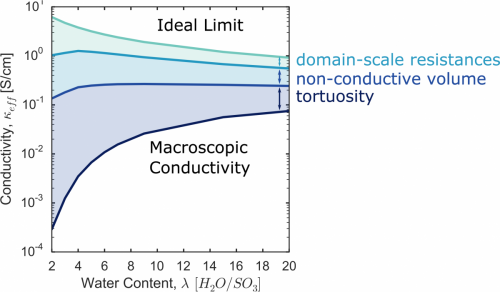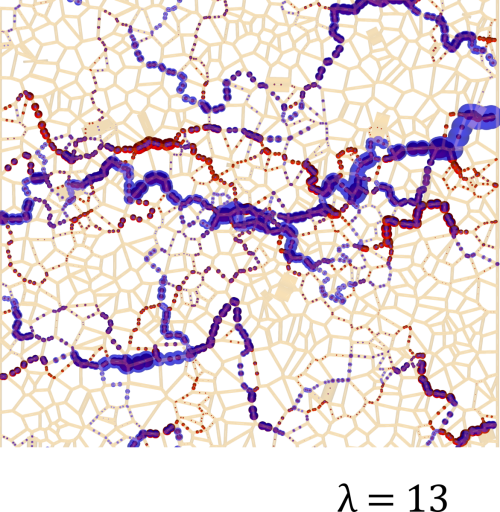Ionomers
Multiscale Transport and Thermodynamics in Ionomers
 Fuel cells, redox-flow batteries, electrolyzes, and electrochemical reduction of CO2 rely on effective movement (i.e. transport) of ions and water in ionomer membranes. For this project, we use theory and simulations to elucidate the underlying physics governing transport and thermodynamic phenomena in ionomers. Using this fundamental mechanistic understanding of molecular transport, we propose design criteria for improving membrane performance.
Fuel cells, redox-flow batteries, electrolyzes, and electrochemical reduction of CO2 rely on effective movement (i.e. transport) of ions and water in ionomer membranes. For this project, we use theory and simulations to elucidate the underlying physics governing transport and thermodynamic phenomena in ionomers. Using this fundamental mechanistic understanding of molecular transport, we propose design criteria for improving membrane performance.
Modeling transport in ionomers is challenging due to the multiple length-scales involved that give rise to emergent transport properties. Specifically, macroscopic membrane properties are the result of transport in a tortuous (mesoscale) network of interconnected, heterogeneous, nanoscale domains. A complete description of these materials, consequently, requires a multiscale approach. We combine mean-field local-density theories at the nanoscale with mesoscale network simulations to model transport phenomena.
 Figures at right: (Top) The multiscale methodology deconvolutes the extent each lengthscale reduces membrane conductivity kappa effective from its ideal limit kappa infinity as a function of membrane water content lambda. Our findings show that ionomers chemistries with reduced tortuosity, higher water volume fraction, and higher nanoscale conductivity will give improved performance. The model outlines how membrane composition changes each of these contributions. (Bottom) Simulations of the mesoscale transport network (tubes) calculates extent of water (blue spheres) and ion (red spheres) transport in ionomer membranes. Each molecule takes distinct pathways across the material with large portions of it remaining inaccessible. Our research suggests tuning mesoscale properties will separately affect different transport modalities.
Figures at right: (Top) The multiscale methodology deconvolutes the extent each lengthscale reduces membrane conductivity kappa effective from its ideal limit kappa infinity as a function of membrane water content lambda. Our findings show that ionomers chemistries with reduced tortuosity, higher water volume fraction, and higher nanoscale conductivity will give improved performance. The model outlines how membrane composition changes each of these contributions. (Bottom) Simulations of the mesoscale transport network (tubes) calculates extent of water (blue spheres) and ion (red spheres) transport in ionomer membranes. Each molecule takes distinct pathways across the material with large portions of it remaining inaccessible. Our research suggests tuning mesoscale properties will separately affect different transport modalities.
Recent Publications:
Crothers, A. R.; Radke, C. J.; Weber, A. Z. Impact of Nano- and Mesoscales on Macroscopic Cation Conductivity in Perfluorinated-Sulfonic-Acid Membranes. J. Phys. Chem. C 2017, 121, 28262-28274.
Crothers, A. R.; Radke, C. J.; Weber, A. Z. Nano- and Mesoscale Ion and Water Transport in Perfluorosulfonic-Acid Membranes. ECS Transactions 2017, 80, 593-604.